The Essential Guide to Silversmithing Jewellery: Tools, Tips, and Techniques
Curious about silversmithing jewellery? This guide dives into the tools, techniques, and unique aspects of crafting beautiful pieces from silver.
Key Takeaways
-
Silversmithing jewellery is a distinct craft focused on creating pieces from silver, emphasising intricate designs and detailed craftsmanship.
-
Essential tools for silversmithing include hammers, pliers, a butane torch, and a jeweller’s piercing saw, which are critical for shaping and detailing silver.
-
The design process for unique jewellery pieces involves gathering inspiration, sketching initial ideas, selecting materials, and refining designs based on feedback.
-
The Silversmithing and Jewellery programme provides a broad, balanced curriculum that includes body adornment and fine metalworking. It also participates in the Glasgow Clyde College Associate Student Scheme for applicants from HNC Art & Design.
Understanding Silversmithing Jewellery
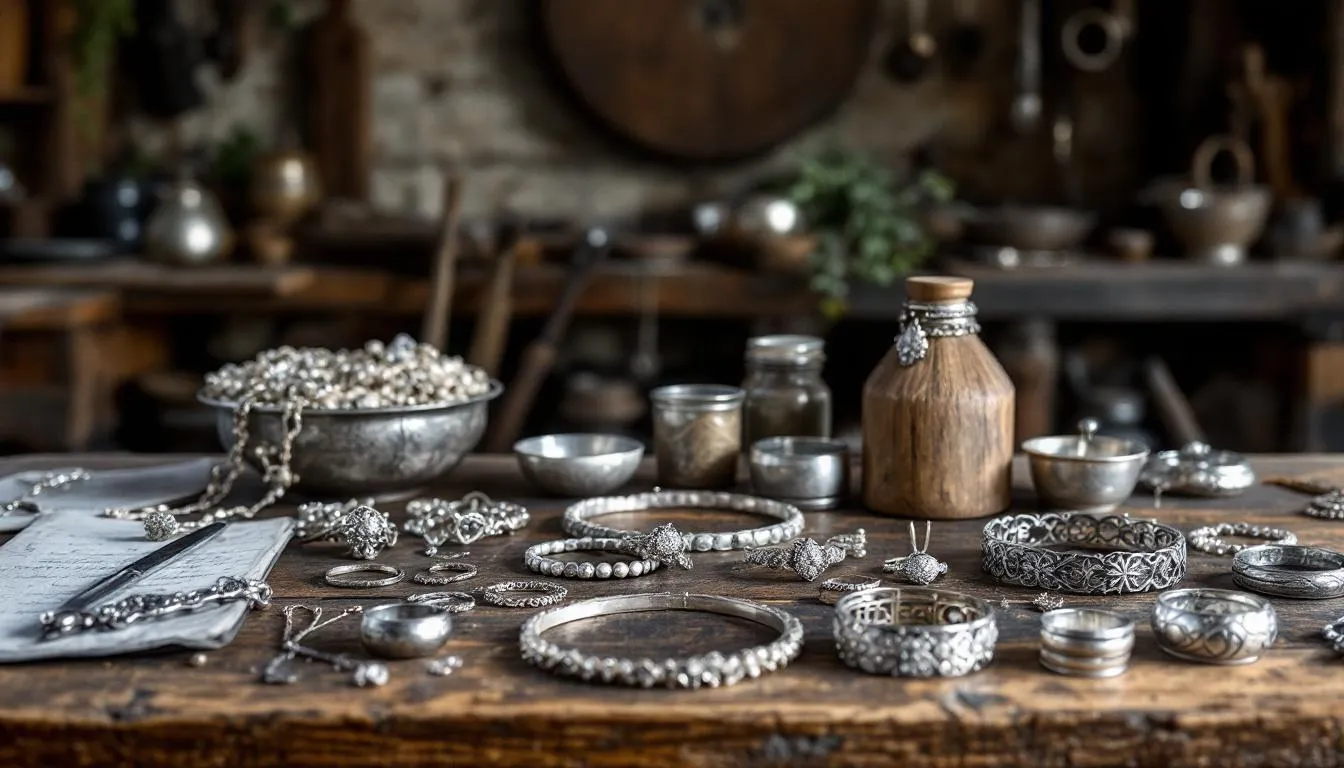
Silversmithing jewellery is a specialized craft that involves creating jewellery from silver, a precious metal cherished for its beauty and malleability. Unlike other forms of jewellery making, silversmithing focuses specifically on working with silver, often incorporating intricate designs and detailed craftsmanship. This ancient art form has evolved over thousands of years, tracing its origins back to civilizations that highly valued silver for its aesthetic appeal and versatility.
Today, the demand for silver jewellery remains high, thanks to its endless possibilities in design and its accessibility compared to other precious metals like gold and platinum. For jewellery makers, silversmithing offers a unique medium to express creativity and precision, setting it apart from other forms of jewellery making that might use a wider variety of metals and materials.
Silversmithing also encourages exploration of different media, including experimenting with various materials and techniques, to develop individual craftsmanship and adapt to new trends in the field.
Whether crafting a delicate necklace or a bold ring, silversmithing allows for a range of artistic expressions that continue to captivate both creators and wearers alike.
Essential Tools for Silversmithing
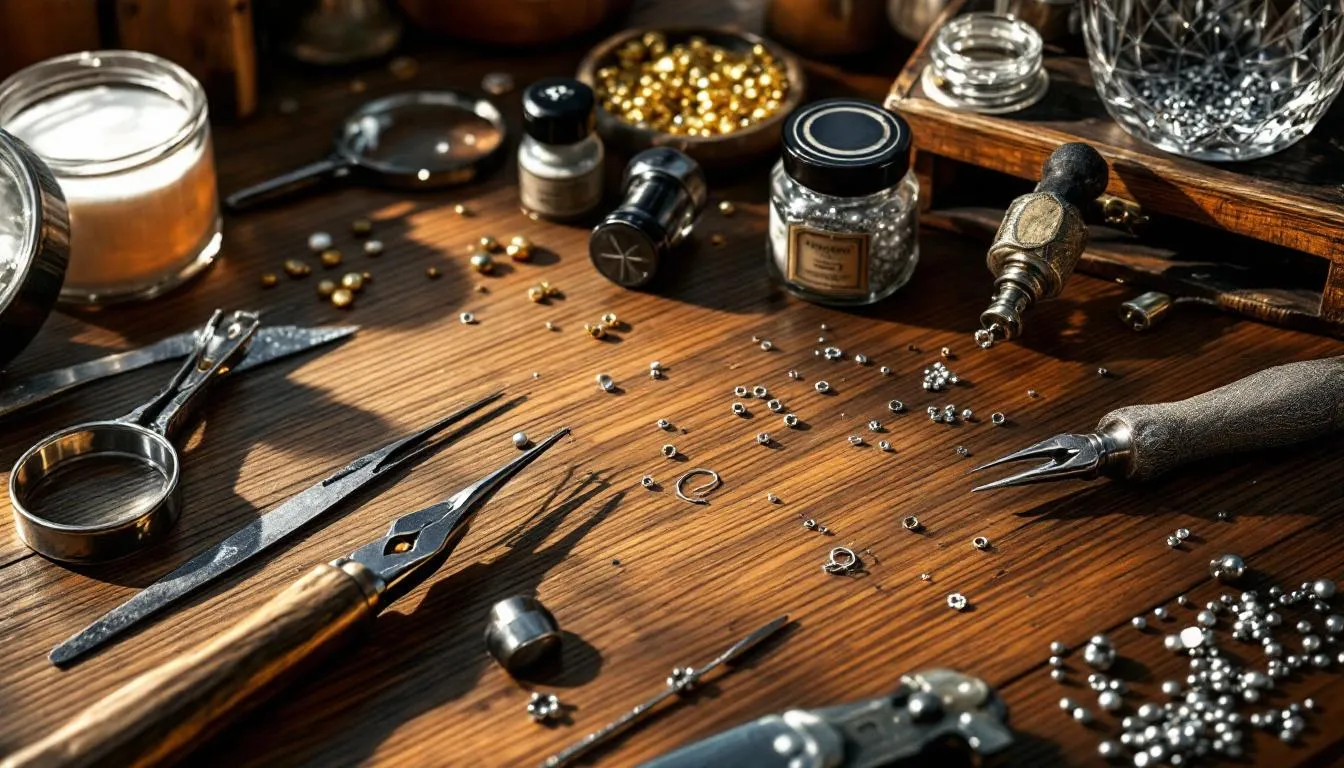
Embarking on the journey of silversmithing requires a well-equipped toolkit. Essential jewellery making tools include:
-
Hammers like the ballpein, which create textures
-
Rawhide hammers that shape metal without leaving marks
-
Pliers such as flat-nose, half-round, and round-nose, indispensable for bending and shaping silver wire and sheets
-
A small butane torch, perfect for soldering and annealing
-
Tools such as thread snips, Jump Ring 'Mate', and The Beadsmith knotting tool are essential for beading.
For intricate cutting and detailed designs, a jeweller’s piercing saw is crucial. It allows for precise cuts and shapes, contributing to the uniqueness of each piece. Additionally, using the correct gauge of saw blades ensures smooth operations without complications. Safety pickle or citric acid is recommended for cleaning silver after soldering, ensuring a polished finish.
A sturdy workbench, preferably made from durable materials like oak or beech, and proper lighting are vital for effective silversmithing. Organizing tools on wall space can keep the workbench clear, enhancing workflow and precision. The right tools not only influence the quality and precision of your jewellery but also make the crafting process more enjoyable and efficient.
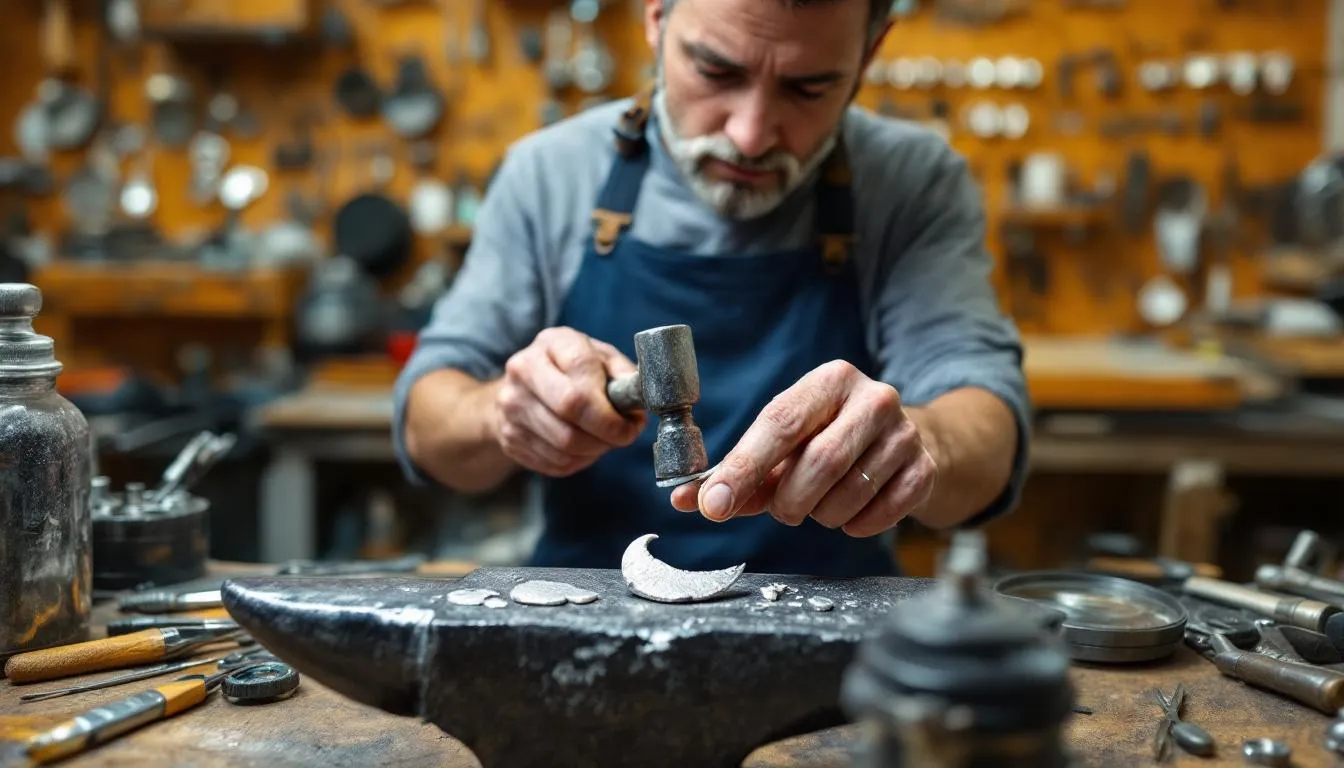
Techniques in Silversmithing Jewellery
The art of silversmithing combines traditional craftsmanship with modern techniques to produce unique and exquisite jewellery. Core techniques include:
-
Forging: shaping metal through hammering.
-
Casting: using molds to create various shapes and designs by pouring melted metal into them.
-
Engraving: a technique requiring a high level of skill and precision.
Engraving adds intricate details and personal touches to jewellery pieces, often using specialized tools to carve designs directly onto the metal surface. This technique can transform a simple piece of silver into a detailed work of art. Additionally, modern technology complements traditional methods, allowing jewellery makers to experiment with new designs and techniques while maintaining the craftsmanship’s authenticity.
Courses focusing on traditional silversmithing techniques, such as ‘Silversmithing – An Emphasis on Traditional Skills,’ help aspiring jewellers master these essential skills. These programs often cover classic techniques like forging and box making, providing a solid foundation for creating stunning silver jewellery. The Silversmithing and Jewellery programme is supported by guest lectures and professional practice workshops. This programme is regularly reviewed and may be subject to validation to improve student experience and graduate prospects.
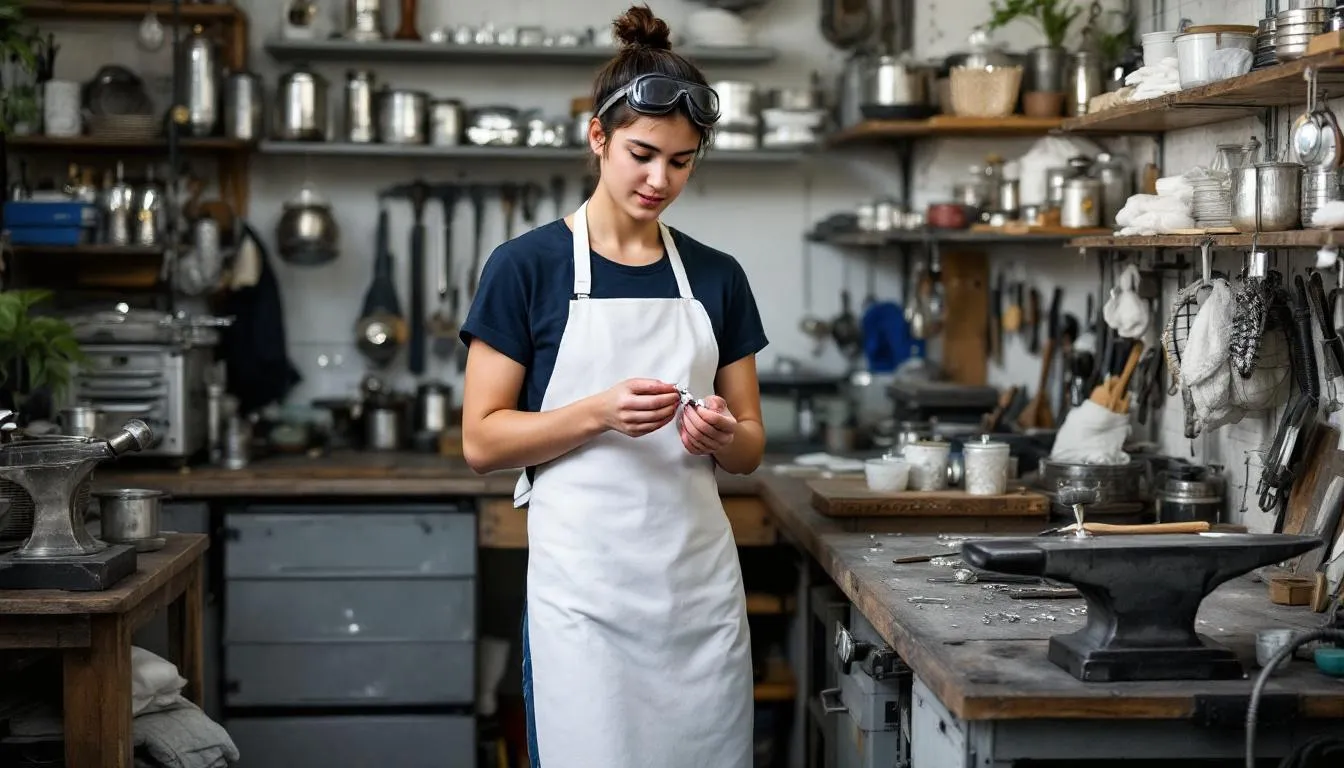
Starting Your Silversmithing Journey
Every silversmith’s journey begins with mastering fundamental skills: designing, sawing, filing, soldering, and finishing. Creating a pleasant and inviting workspace enhances creativity and motivation, making the silversmithing process more enjoyable. A comfortable chair at the right height is important for maintaining good posture during long work sessions, while regularly tidying up the workspace helps maintain an organized environment conducive to creativity.
Beginners can benefit from easy workshops like ‘Silver Stacking Rings,’ which teach how to learn to make custom silver rings. Positive feedback from participants, like Denise Mountain Pike’s satisfaction with the friendly and understanding service, underscores the supportive environment for beginner newcomers in jewellery making. Additionally, students will learn to work with metal clay in the Silverclay Jewellery Workshop to create beautiful jewellery. Here are some tips for getting started.
Starting your silversmithing journey is a rewarding experience that blends creativity, skill, and patience.
Designing Unique Pieces

Designing unique jewellery pieces involves several key steps:
-
Gathering inspiration from diverse sources such as fashion, nature, and art.
-
Defining a purpose behind the jewellery piece to guide the overall design process and enhance its personal significance.
-
Starting the design process with initial sketches and honing your design skills.
-
Refining the sketches through collaboration and feedback.
Selecting appropriate materials, including gemstones and metals, is crucial as they influence the final aesthetic and emotional impact of the jewellery. Techniques like stamping, where designs are imprinted onto metal using a die, allow for letters and decorative patterns to be added.
Wire working and beading are other popular techniques; wire working involves bending and shaping wire to create intricate designs, while beading strings beads together to form jewellery items ranging from simple to complex.
Enamelling, which applies glass to a metal surface and fires it to create vibrant colors and textures, adds another layer of uniqueness to the jewellery. Each piece designed reflects the jeweller’s creativity and skill, resulting in beautiful and meaningful creations.
Workshop Setup for Silversmiths
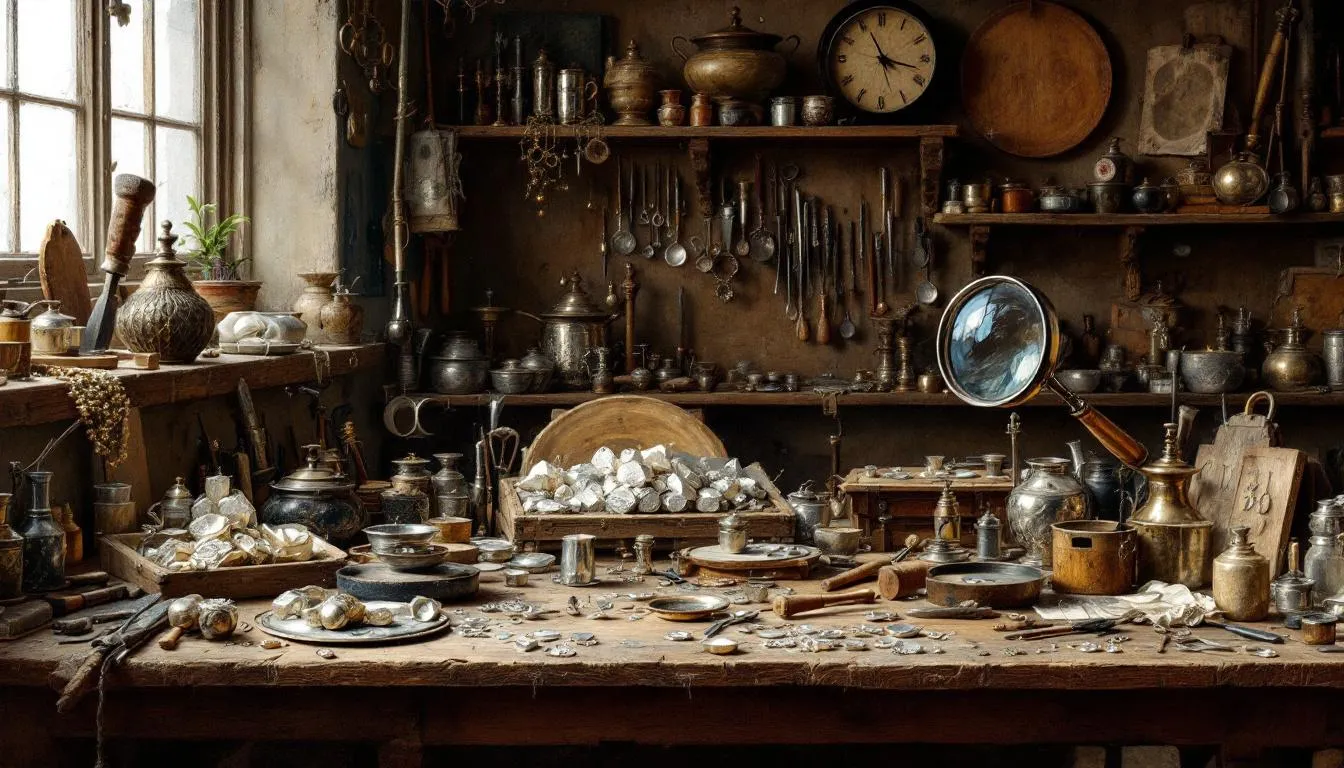
Setting up a functional and organized workshop is essential for successful silversmithing. Basic tools include a piercing saw, hammers, pliers, and a blowtorch, while essential materials for beginners consist of metal sheets, flux, a torch, and a pickle pot. Jewellery making tool kits are great for beginners to start their jewellery making journey.
Utilizing wall space for tool storage helps keep the workbench clear and organized, enhancing workflow. Adequate lighting is important to avoid accidents and ensure precision during intricate tasks. A well-equipped and organized workshop provides the foundation for creating beautiful and precise silver jewellery.
Silver vs. Other Precious Metals
When comparing silver to other precious metals like gold and platinum, several factors come into play:
-
Silver’s price volatility is significantly higher than gold’s.
-
Daily price movements of silver are often two to three times greater than those of gold.
-
This higher volatility can make silver a more dynamic and potentially lucrative investment for jewellery makers.
-
Silver jewellery making is closely related to making jewellery out of other precious metals such as gold.
-
Silver’s price volatility is significantly higher than gold’s.
-
Daily price movements of silver are often two to three times greater than those of gold.
-
This higher volatility can make silver a more dynamic and potentially lucrative investment for jewellery makers.
However, silver is softer than both gold and platinum, making it more prone to scratches and dents in everyday use. Despite these challenges, silver’s beauty and versatility continue to make it a popular choice for jewellery makers who appreciate its unique properties and the creative possibilities it offers.
Maintaining and Caring for Silver Jewellery
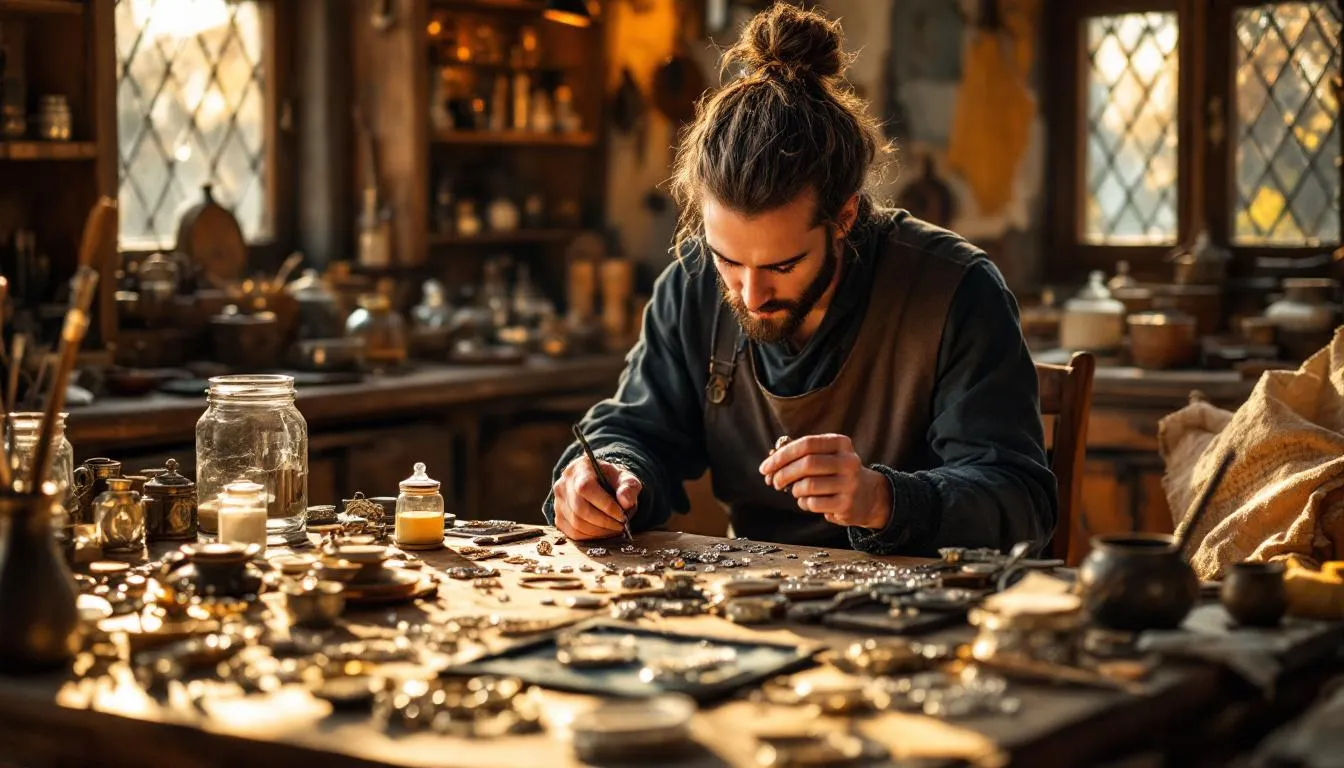
Maintaining and caring for silver jewellery involves understanding differences in metal types, such as gold plated jewellery, different gold plating types for jewellery:
-
Regular cleaning and proper storage to prevent tarnishing.
-
Gently rubbing silver with a soft cloth.
-
Rinsing thoroughly with warm water as an effective cleaning method.
Silver’s bright, reflective quality makes it a beloved choice, but you may choose it over gold and platinum, as it is more susceptible to tarnishing than gold and platinum, requiring more maintenance.
To care for silver jewellery, such as a Sterling Silver Eye Necklace – A Symbol of Protection and Style:
-
Store it in a dry place, ideally in tarnish-proof cloth or bags, to help prevent tarnishing.
-
In humid climates, place desiccant crystals in storage to keep silver dry and maintain its shine.
-
For oxidized silver, avoid using silver polish as it can remove the oxidized finish and requires special care.
Regular use of silver jewellery can minimize the need for maintenance, as it typically tarnishes less when frequently worn. Avoid exposing silver to bleach and strong chemicals, which can accelerate tarnishing. With proper care, silver jewellery can retain its beauty and luster for years to come.
Resources and Courses for Aspiring Silversmiths
Aspiring silversmiths have access to a wealth of resources and courses to develop their skills. Courses in silversmithing jewellery can lead to further skills development, alternative career paths, or future studies in creative arts. The Silver Clay Jewellery Workshop offers a 10-week introductory course for beginners, providing step-by-step guidance for creating intricate pieces. Entry requirements and application processes for the Silversmithing and Jewellery programme are outlined in an application guide. Prospective students can apply for the programme by submitting an application according to eligibility criteria, with options for Year 1 or direct Year 2 admission, and should be aware of application timelines such as Clearing.
The programme offers a comprehensive study experience, including opportunities for study abroad, engagement in research activities, and personal development through academic and practical learning.
Resources and support for jewellery-making students include:
-
Courses in copper clay jewellery that encourage participants to explore unique designs and techniques.
-
Specialist reading lists available at libraries, offering in-depth knowledge and inspiration.
-
Support and guidance from experienced teams, enabling significant growth in jewellery-making skills.
Customer Stories and Inspirations
Customer stories and inspirations play a crucial role in the world of silversmithing. Yvette Cannon, with over 30 years of experience in jewellery making, and Samantha O’Brien, a passionate silversmith jeweller, are among the many who have found joy and fulfillment in this craft. Interactive competitions and customer engagement initiatives, as noted by Kim Thomson, enhance creativity and build a sense of community among jewellery makers. The Glasgow School of Art has an extensive exchange programme with leading Art, Design and Architecture schools.
Frank Wilson’s reliance on high-quality findings and pearls from his supplier since starting his business eight years ago highlights the importance of excellent quality materials and trusted partnerships in the jewellery-making journey. These stories serve as a source of inspiration and motivation for aspiring silversmiths to find their path.
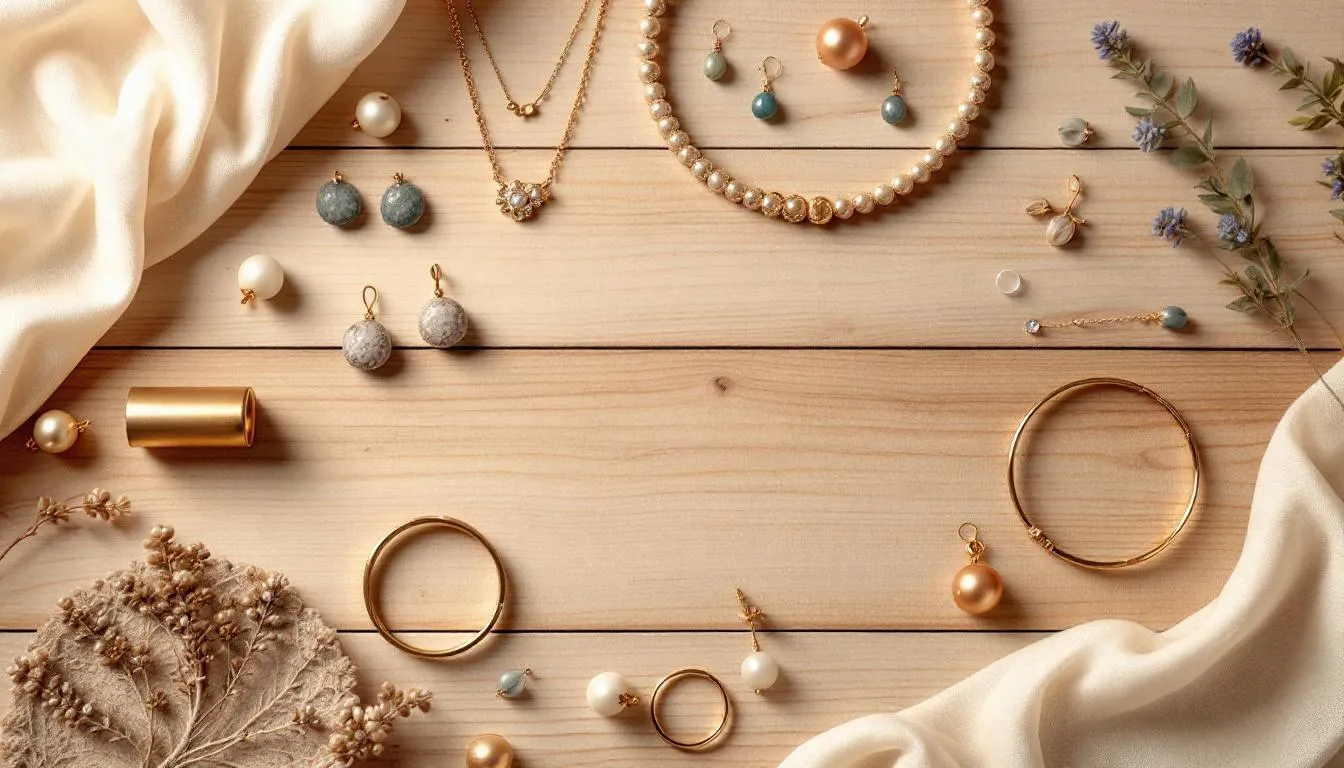
Our Story: Sarasbeads & Jewellery
Sarasbeads & Jewellery was founded in 2019 by Sarah, who transitioned from a hobby to a business in 2021. The company originated from Lebanon and reflects a family legacy as it evolves into a family-run business. The brand aims to provide a unique selection of modern jewellery that brings joy to customers.
Emphasizing high-quality materials, Sarasbeads & Jewellery ensures all products are hypoallergenic and suitable for sensitive skin. The first market stall was established in local schools, showcasing the brand’s products to the community.
Customer feedback and appreciation play a crucial role in the brand’s continued success and development.
The Genesis of Sarasbeads & Jewellery
Sarasbeads & Jewellery began as a personal passion project for Sarah in 2019. What started as a hobby to capture happy moments through the creation of handmade bracelets and necklaces blossomed into a thriving business in 2021. Each piece crafted by Sarah was infused with love, transforming challenging times into beautiful creations that brought joy and positivity to others.
This dedication to craftsmanship and the inherent desire to spread happiness laid the foundation for what Sarasbeads & Jewellery is today.
A Family Legacy: From Beirut to the UK
As Sarasbeads & Jewellery continues to evolve, it proudly embraces its identity as a family business. The roots of this venture trace back to Beirut, Lebanon, a city that profoundly influenced Sarah’s early life and creative spirit. The vibrant colors of the Mediterranean Sea, a constant source of inspiration, are often reflected in the unique designs of our jewellery. These elements are meticulously designed to bring smiles to your faces and to those you cherish. If you have any questions or need support, please contact us.
The journey from Beirut to the UK has been one of adaptation and growth, allowing us to blend rich cultural heritage with modern design sensibilities. Our distinctive range of modern and unusual jewellery is a testament to this fusion, offering pieces that are not only beautiful but also carry a piece of our history and passion.
Milestones and Community Engagement
Community engagement has been at the heart of Sarasbeads & Jewellery’s journey. From the early days of setting up stalls in local schools to participating in larger community events, these interactions have helped foster connections between artists and residents, enhancing the cultural fabric of local areas.
These milestones reflect our commitment to supporting and being a part of the communities we serve.
Finding My Passion in Tough Times (December 2021)
December 2021 marked a pivotal moment for Sarasbeads & Jewellery. It was during this period that Sarah truly found her passion, channeling her creativity into crafting unique handmade bracelets and necklaces. This endeavor not only provided a personal outlet but also became a means to share joy and positivity with others through her art.
The experience of crafting served as a therapeutic outlet during challenging times, allowing Sarah to touch her emotions creatively.
Sarah's Inspiration: The Colors of the Mediterranean
Born and raised in Beirut, Lebanon, Sarah’s childhood experiences deeply influenced her artistic vision. The lovely mesmerizing hues of the Mediterranean Sea served as a primary inspiration for her initial creations, particularly the unique bracelets that inspired the launch of Sarasbeads & Jewellery.
Natural landscapes, like the Mediterranean, can profoundly influence an artist’s work, shaping their color palette and style.
Community Showcase: Our First Steps
Start our journey into the public sphere began with our first order stalls at the Lycée International de Londres Winston Churchill and St. Nicholas Primary School, which later became Buxlow Primary School. These venues, being the schools of our children, provided a wonderful opportunity to connect with and showcase our products to both communities. The enthusiastic reception and success of these initial programmes fueled our motivation to participate in further community gatherings across Harrow, Wembley, and Edgeware.
Participating in local school events provided invaluable exposure and strengthened our community ties. These early engagements were instrumental in building our brand’s reputation and establishing a loyal customer base, laying the groundwork for future growth and expansion.

Expanding Horizons: From Local Markets to Major Venues
Building on the success of our community engagements, Sarasbeads & Jewellery embarked on an ambitious expansion of its market reach. We began trading at numerous locations, including:
-
Windsor
-
Burnt Oak
-
Watford
-
Gravesend
-
Headstone
-
Richmond
-
Romsey
-
Oxford
-
Bicester
-
Reading
-
Newbury
-
Southampton
-
Coventry
-
Enfield
-
The prestigious London Stock Exchange
-
The bustling London Designer Outlet
-
Westfield Stratford
-
Westfield White City
-
Kensington
-
Fulham
-
Acton
-
Islington
This extensive outreach allowed us to connect with a diverse customer base and establish our team presence across various regions that vary, leaving us impressed with the excellent delivery deal.
Our participation in these major venues not only expanded our market reach but also provided us with valuable insights into different customer preferences and trends. This knowledge has been crucial in refining our product offerings and enhancing our overall customer experience.
A Dream Realized: Our First Store
The culmination of Sarah’s unwavering persistence and consistency, coupled with the invaluable support of her family—Khalil, Yusuf, Mohamad, and Karim—led to a significant milestone: the opening of our first physical store at St. George’s Shopping Centre in Harrow. This achievement marked a new chapter for Sarasbeads & Jewellery, providing a dedicated space to showcase our evolving collection.
The store’s opening was a dream realized, offering a perfect place for customers to experience our jewellery in person, make purchases, visit, and engage with our brand on site. It also served as a testament to our journey from humble beginnings to a recognized name in the jewellery-making world, present shop.
The Evolution of Our Craft
Our journey, which began with simple beads and charms, has continuously evolved to embrace a broader spectrum of exquisite jewellery. Today, our collection proudly includes bespoke Sterling Silver and meticulously Handmade Gold Plated Jewellery, gold-plated, including sterling silver pieces often adorned with beautiful semi-precious stones. This evolution reflects our commitment to innovation, quality, and our ongoing dedication to offering unique and cherished pieces to our customers. To learn more about our approach to jewelry and stay informed about the latest trends and techniques, explore our articles.
Each piece in our collection is a testament to our growth as jewellery makers, blending traditional craftsmanship with contemporary design. As we look to the future, we remain committed to improving our skills, learning new techniques, and continuing to create pearl jewellery that resonates with our customers around the world.
Summary
In summary, the world of silversmithing jewellery is a rich and rewarding field that combines creativity, skill, and tradition. From understanding the essential tools and techniques to starting your journey and designing unique pieces, silversmithing offers endless possibilities for artistic expression. The story of Sarasbeads & Jewellery further illustrates the passion and dedication required to succeed in this craft. We hope this guide has inspired you to explore silversmithing and embark on your own creative journey, crafting beautiful pieces that bring joy to you and others.
Frequently Asked Questions (FAQs)
What is silversmithing jewellery?
Silversmithing jewellery is the art and craft of creating jewellery pieces specifically from silver. It involves techniques such as cutting, shaping, soldering, and finishing silver to produce unique and intricate designs.
What tools do I need to start silversmithing jewellery?
Essential tools for beginners include hammers, pliers, a jeweller’s piercing saw, a butane torch, and safety equipment. Jewellery making tool kits are also available and provide a great starting point for those new to the craft. Kernowcraft has an extensive range of jewellery making tools for beginners and professional metalsmiths, making it easier to find the right tools for any project.
Can beginners learn silversmithing jewellery easily?
Yes, beginners can learn silversmithing jewellery through workshops, courses, and guided tutorials that cover basic skills like sawing, soldering, and finishing. Many courses offer hands-on experience to build confidence and design skills.
How does silversmithing differ from other jewellery making?
Silversmithing focuses specifically on working with silver, a precious metal known for its malleability and beauty. While related to other precious metals like gold, silversmithing techniques may vary slightly due to silver’s unique properties.
How do I care for and maintain silver jewellery?
To maintain silver jewellery, regularly clean it with a soft cloth, store it in dry, tarnish-proof containers, and avoid exposure to harsh chemicals. Proper care helps preserve its shine and prevents tarnishing.
Where can I find silversmithing jewellery courses?
Many art schools and community centres offer silversmithing jewellery courses, including beginner workshops and advanced programmes. Some programmes also provide opportunities for study abroad and professional development.
What materials besides silver can I use in jewellery making?
While silver is the primary material in silversmithing, jewellery makers often explore other metals like gold, copper, and platinum, as well as gemstones, beads, and enamelling materials to enhance their designs.
How long does it take to become proficient in silversmithing jewellery?
The time to proficiency varies depending on the individual and the intensity of practice. Beginners can create simple pieces within weeks, while mastering advanced techniques may take months or years of dedicated study and practice.
Can I sell my silversmithing jewellery creations?
Absolutely! Many jewellery makers sell their creations through local markets, online stores, and galleries. Building a brand and participating in community events can help grow your customer base and business.
What safety precautions should I take when silversmithing?
Always use protective gear such as safety glasses and gloves, ensure proper ventilation when soldering, and keep your workspace clean and organized to avoid accidents. Following safety guidelines is essential for a safe and enjoyable crafting experience.

 https://sarasbeads.co.uk
https://sarasbeads.co.uk